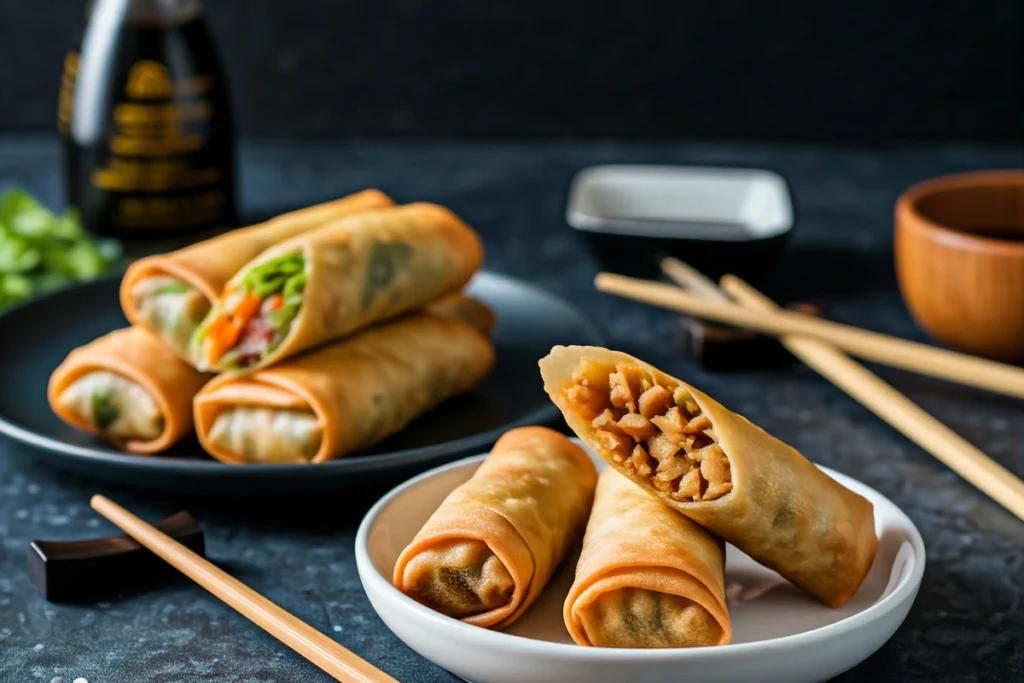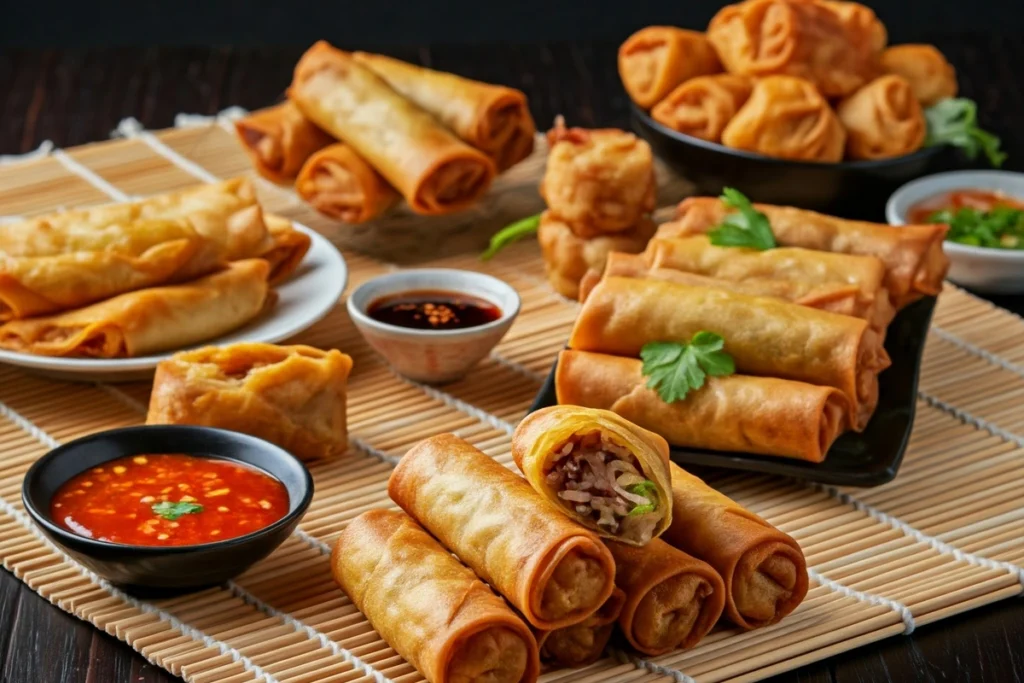Egg rolls are a popular appetizer in Chinese restaurants across the globe, but have you ever stopped to wonder, are egg rolls Chinese? While they’re undeniably linked to Chinese cuisine in the minds of many, their origins, evolution, and variations tell a fascinating story.
In this article, we’ll dive deep into the history of egg rolls, explore how they compare to traditional Chinese spring rolls, and uncover the secrets behind their rise to fame. We’ll also look at the ingredients, cooking methods, and cultural significance to answer the age-old question: Are they truly Chinese, or is their identity more complex?
Introduction to Egg Rolls
What Are Egg Rolls?
Egg rolls are crispy, fried rolls filled with savory ingredients such as cabbage, pork, and spices. They’re a quintessential item on Chinese-American restaurant menus and are often served with dipping sauces like sweet-and-sour or soy sauce. Wrapped in a thick, wheat-based wrapper, they’re deep-fried to achieve that signature golden crunch.
Despite their ubiquity in Chinese-American dining, egg rolls are somewhat of an enigma. Unlike traditional Chinese spring rolls, egg rolls have a heavier wrapper and a more substantial filling. So, where do they really come from?
Why the Question: Are Egg Rolls Chinese?
The debate over whether egg rolls are Chinese stems from their fusion origins. While egg rolls have roots in Chinese cuisine, they’ve been heavily influenced by American tastes. Traditional Chinese spring rolls, their closest relative, feature thinner wrappers and a lighter texture.
Some believe egg rolls evolved in the United States as a heartier take on spring rolls, adapted for local preferences. Others argue that they’re an authentic extension of Chinese culinary traditions. This blend of history and cultural fusion raises intriguing questions about authenticity and identity in food.
As we dig into their story, it becomes clear that egg rolls represent more than just a delicious snack—they’re a symbol of culinary adaptation and cultural exchange. Let’s explore this crispy, savory mystery in the sections ahead.
The Origins of Egg Rolls
The Chinese Spring Roll Connection
Egg rolls are often seen as an evolution of the Chinese spring roll, a dish with ancient roots in Chinese culture. Spring rolls, typically made with thin wrappers and filled with vegetables or meat, have been a staple in Chinese cuisine for centuries. They are traditionally associated with Lunar New Year celebrations, symbolizing prosperity and wealth.
However, are egg rolls Chinese in the same sense? While they share similarities, their thicker, crispy shell and heartier fillings distinguish them from spring rolls. Some historians believe Chinese immigrants to America adapted spring rolls to suit Western tastes, creating what we now know as egg rolls. This adaptation might explain their popularity in Chinese-American restaurants, where innovation often meets tradition.
The Evolution of Egg Rolls in America
The modern egg roll as we know it likely emerged in the early 20th century, during the boom of Chinese-American cuisine. Immigrants created dishes that appealed to American palates, blending familiar ingredients with a touch of novelty. Unlike the lighter, delicate spring rolls, egg rolls became a deep-fried, flavor-packed appetizer that resonated with the growing demand for crispy, savory dishes.
Egg rolls gained mainstream appeal thanks to their inclusion on restaurant menus, where they were marketed as a quintessential Chinese appetizer. But their history reveals a journey shaped by cultural exchange and culinary adaptation, rather than strict adherence to Chinese culinary traditions.
For another take on cultural fusion in cooking, explore Simita Recipes’ guide to How to Make Chinese Egg Rolls.
Traditional vs. Modern Egg Rolls
Ingredients and Preparation: Traditional Chinese vs. American Egg Rolls
Traditional Chinese spring rolls often include finely shredded vegetables, vermicelli noodles, and light seasonings wrapped in a delicate rice or wheat wrapper. In contrast, American egg rolls feature a thicker, doughier wrapper filled with a robust mixture of cabbage, pork, shrimp, or even fusion ingredients like cheese.
The preparation methods also differ significantly. While spring rolls are often pan-fried or steamed, egg rolls are deep-fried to achieve their signature crunch. This difference highlights the American penchant for crispy, indulgent textures, setting egg rolls apart from their counterparts.
How Ingredients Reflect Regional Influences
The choice of ingredients in egg rolls often reflects regional and cultural influences. For instance, some versions include barbecue pork for a sweet-savory twist, while others embrace spicy flavors with chili or curry additions. This flexibility in filling showcases the fusion of Chinese techniques with global culinary trends.
The diversity of worldwide raises a key question: are egg rolls Chinese, or have they evolved into a uniquely international dish? Their adaptability suggests that while their roots are Chinese, their identity is shared by many cultures.
Are Egg Rolls a Chinese Dish? A Debate
Arguments for Egg Rolls as a Dish
Some food historians and chefs argue that egg rolls are Chinese because they share roots with traditional Chinese spring rolls. The technique of wrapping and frying fillings in thin dough is undeniably Chinese in origin. The spices and seasonings used in egg rolls, such as soy sauce and ginger, also reflect classic Chinese culinary practices.
Moreover, egg rolls are frequently featured in Chinese-American restaurants, leading many to associate them closely with Chinese cuisine. This connection has solidified their identity as a cultural bridge between authentic Chinese dishes and Western interpretations.
Why Some Say Egg Rolls Are Not Authentic Chinese
Critics of the claim that egg rolls are Chinese highlight their departure from traditional recipes. The thicker wrappers and deep-fried preparation cater more to American tastes than to Chinese culinary norms. Authentic spring rolls, by contrast, are lighter and more delicate, focusing on subtle flavors.
Additionally, the inclusion of unconventional ingredients like cheese or ground beef points to egg rolls being a fusion dish rather than a purely Chinese creation. This adaptability makes them a symbol of Chinese-American innovation rather than a representation of authentic Chinese food.
To explore more about authentic Chinese appetizers, you might enjoy Simita Recipes’ guide to Chinese Egg Rolls.
How Egg Rolls Became a Takeout Staple
The Role of Chinese-American Restaurants
The popularity of egg rolls skyrocketed as Chinese-American restaurants gained traction in the mid-20th century. These establishments introduced Western diners to a hybrid version of Chinese cuisine, where egg rolls quickly became a go-to appetizer. Their crispy texture, savory filling, and compatibility with various dipping sauces made them irresistible.
Egg rolls also played a significant role in shaping perceptions of Chinese food in the West. As a recognizable and widely loved dish, they became synonymous with Chinese-American cuisine, even appearing on menus of non-Chinese establishments.
Fusion Cuisine and the Egg Roll’s Global Popularity
Egg rolls represent the perfect marriage of tradition and adaptation. As they traveled beyond the United States, local variations emerged to suit different palates. In Latin America, for example, egg rolls sometimes feature fillings like plantains or chorizo, while in the Philippines, they share similarities with lumpia.
Their versatility has cemented their place as a global favorite. Whether served at a Chinese-American takeout spot or reimagined in a gourmet kitchen, egg rolls continue to evolve.
For those inspired to try making egg rolls at home, Simita Recipes offers tips and ideas for creating your own unique take on this iconic dish.
Comparing Egg Rolls to Similar Dishes

Spring Rolls vs. Egg Rolls: Key Differences
The comparison between spring rolls and egg rolls often fuels the debate, are egg rolls Chinese? While both dishes involve rolling a filling in a wrapper, their differences are striking.
Spring rolls, which are deeply rooted in Chinese traditions, feature thin, delicate wrappers made from rice or wheat. These rolls are typically lighter, with fresh or lightly cooked vegetables and sometimes meat. They can be fried or served fresh, depending on the recipe.
Egg rolls, by contrast, boast a thicker, doughier wrapper and a heartier filling. Deep-fried to golden perfection, egg rolls offer a crunchier texture and a richer taste, making them a distinctly American creation.
Are Lumpia and Egg Rolls Related?
Lumpia, a popular dish in the Philippines, is another roll that invites comparisons to egg rolls. Like spring rolls, lumpia uses a thinner wrapper and often contains ground pork, shrimp, or vegetables. However, lumpia differs from egg rolls in preparation and presentation.
Though lumpia shares similarities with both spring rolls and egg rolls, its origins are distinct, tracing back to Southeast Asia. The crossover of these dishes highlights the shared techniques of wrapping and frying across Asian cuisines, yet it also reinforces the uniqueness of egg rolls as a fusion dish.
The Mystery of the Egg in Egg Rolls
Do Egg Rolls Actually Contain Eggs?
Surprisingly, most modern egg rolls don’t contain eggs in the filling or wrapper, which begs the question: are egg Chinese if the name itself seems misleading? Historically, some recipes used eggs to make the wrapper dough, which may explain the origin of the term.
Over time, the practice of adding eggs faded, but the name stuck. Today, the wrapper’s texture and golden color, achieved through frying, might also evoke the idea of eggs, further justifying the moniker.
Theories Behind the Name “Egg Roll”
Several theories attempt to explain the name “egg roll.” One suggests that it stems from the Chinese word for a rolled omelet, which some say inspired the dish’s early forms. Another theory ties the name to the golden appearance of the fried wrapper, resembling the color of egg yolks.
Regardless of its origin, the name has become a defining part of the egg roll’s identity. While it may not directly tie to its ingredients, it captures the curiosity and charm of this beloved appetizer.
Popular Egg Roll Variations Worldwide
American and Western Takes on Egg Rolls
Egg rolls have become a culinary canvas for chefs worldwide, especially in Western countries. In the United States, egg rolls are typically stuffed with cabbage, pork, or shrimp, but creative versions include Tex-Mex fillings like beans, cheese, and jalapeños. These variations demonstrate the dish’s adaptability to local flavors while maintaining its iconic crunch.
In some cases, even dessert versions of egg rolls have emerged, filled with ingredients like chocolate or cream cheese. This expansion of egg roll recipes adds to their popularity and versatility, showing how they have grown beyond their Chinese-American origins.

Asian Variations: Exploring Regional Twists
Across Asia, similar rolls reflect local traditions and tastes. For instance, Vietnamese fried spring rolls (cha gio) and Filipino lumpia both share similarities with egg rolls but have distinct ingredients and preparation methods. These dishes typically use thinner wrappers and lighter fillings.
While egg share some techniques and textures with these regional dishes, they remain uniquely tied to their Chinese-American roots. The question, are egg rolls Chinese, continues to highlight their hybrid nature, bridging different culinary worlds.
FAQs About Egg Rolls
Are Egg Rolls an Authentic Chinese Dish?
The short answer: not entirely. While egg rolls are inspired by traditional spring rolls, their thicker wrappers, deep-fried preparation, and robust fillings make them more of a Chinese-American innovation. They reflect how immigrant communities adapt traditional recipes to local tastes.
What Is the Difference Between Egg Rolls and Spring Rolls?
Spring rolls are lighter and often use rice paper or thin wheat wrappers, while egg rolls are thicker, heartier, and always fried. Spring rolls are also more likely to feature fresh vegetables or lighter fillings, whereas egg rolls are known for their crispy exterior and savory stuffing.
Why Are Egg Rolls So Popular in America?
Egg rolls gained popularity through Chinese-American restaurants, which introduced diners to this flavorful, crunchy appetizer. Their bold taste, rich filling, and versatility made them a favorite in Western cuisine.
For those eager to dive deeper into roll recipes, check out Simita Recipes’ How to Make Chinese Egg Rolls for more tips and inspiration.

